The story of the designer, endearing math
The author of the material is a mobile application designer. In her post, she describes in detail her own way in mastering mathematics, and also talks about the impact that exact sciences had on her main work.

Math irritated me. In my youth, it seemed to me completely pointless to spend so much time on solving mathematical problems when there were so many other interesting activities around!
')
While studying at the university, I enrolled in an interactive arts course. They showed me how to create with the help of the code in Processing . Here is one example - the wonderful work of Marius Watts (since then I have been a fan of him).
Attention! Contains an overdose of awesome awesomeness.
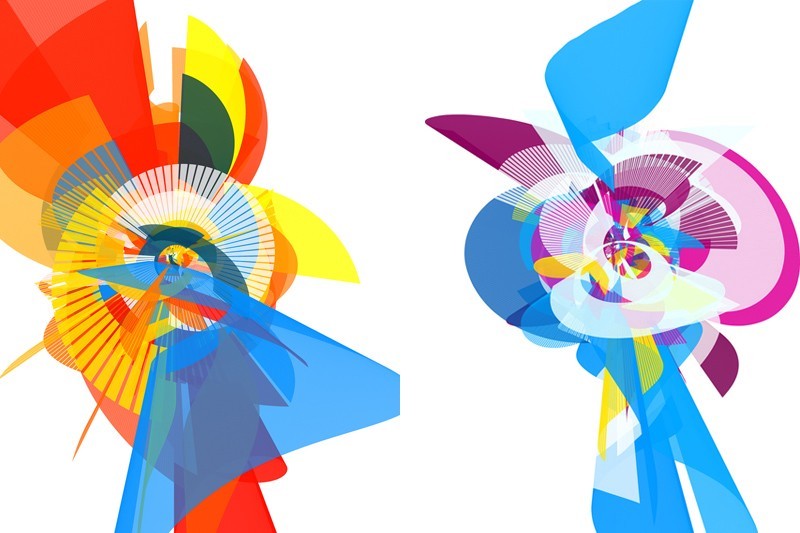
Being an ambitious student, I tried to reproduce the style as best I could, without seeking to delve into things that were unpleasant to me. For example, I did not want to understand sin (something there) or cos (something there).

Khe-khe double loop
To be honest, I was pleased with my work. It looked interesting, and I spent much less time on it than if I did the same in Illustrator or Photoshop. And yet, I realized that without an understanding of geometry, I had no chance even to come closer to what Marius Wats was doing.
Of all the branches of mathematics, I disliked trigonometry the most. But what the difference! If you can use it to create the same cool stuff, I’m ready to sell my soul to learn math.

I recommend watching the video for high school students.
Finding the study material was surprisingly easy. They are everywhere! If you are put to sleep by the sleepy voice of one presenter and the content seems too difficult to understand, there are always thousands of alternatives. Personally, I watched the Korean math teacher's YouTube channel (I'm just familiar with the content of the textbook and Korean math norms).
I can not say that I amused myself, but it helped me to understand what Marius Watz was doing: when he used cosine for position x and sine for position y.
He just put a dot on the circle!
Instead of numbers, he used trigonometric variables, so he could draw a point moving in a circle!
Even when I understood the basics of trigonometry, I lacked the confidence to apply them in design. I decided to use them on something else, even if it comes out funny and not very clever. From the point of view of aesthetics, it happened somewhere in the region of its complete opposite.
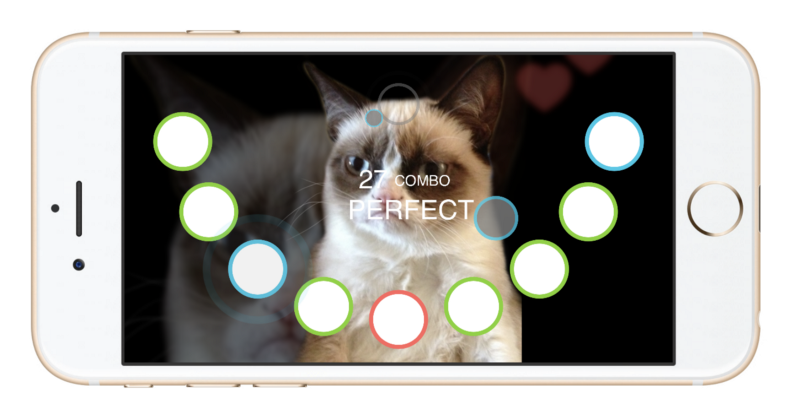
http://share.framerjs.com/ejaybmwm4k95/
At that time, I understood: even if you share something that you yourself think is nonsense, you can still inspire others, make them smile or smile. So I got the motivation to create new concepts and start exploring the fundamental areas of geometry.
If you do not know where you can apply new knowledge on trigonometry - make a boot spinner (it is also a circular load indicator). I used Framer for prototyping.
Development of animations for spinner has become my favorite hobby. In any case, it looks better than a simple rotating circle, while it is not so difficult to do. You only need to think about three things:

https://framer.cloud/ZePNP/

http://share.framerjs.com/e9f5sfvmrapa/
All I needed: these three steps + knowledge of the basics of trigonometry. Just like that!
For working with triangles / stars / polygons, the choice of tools is important. There are those where you can enter two points, and the system connects them with a line.
In my case, I did not use Framer. Alternatively, I could draw a rectangle and rotate it so that it turned into a line.

At first I practiced creating different shapes based on a triangle.
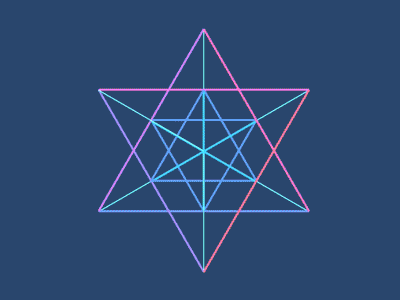
https://framer.cloud/rJ68Ono4g/
Mastering mathematics brings more satisfaction when you impose additional restrictions!
At this point, I began to say that I love math. I studied polygons and created concepts during the Christmas holidays. This is the most exciting thing I've ever had to learn.
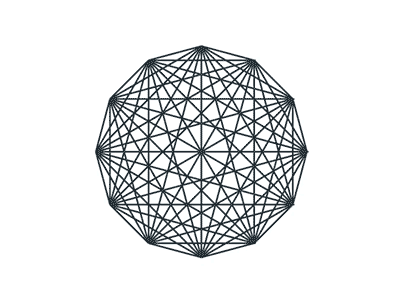
https://framer.cloud/H1fWocJSg/
Before I got to know them better, the polygons seemed to me similar to cookie cutters. I opened Photoshop, Illustrator or Sketch and selected the necessary tool for a polygon. I could change the number of vertices from 5 to 12 - almost how to choose different molds for cookies from the box. That's all I knew about the landfills.

Octagon skeleton
Having learned more about polygons, I realized that these are beautiful structures from triangles that are just waiting to turn into something more!
As I said, there are tools with which you can draw a line from point A to point B. Fortunately, this also applies to Processing! And it’s really easy to draw arcs. It revived my creative side in using mathematics.

Work in progress!

Sketches
Despite the fact that Processing is a slightly outdated language today, it has an excellent feature - the image can be exported to a pdf-file. This means that you can add more details in other programs, for example, in Illustrator and Photoshop.

Color version
Having understood trigonometry, triangles and polygons, you can draw anything, combining them together.
And you can sometimes fail, but it is even funny.
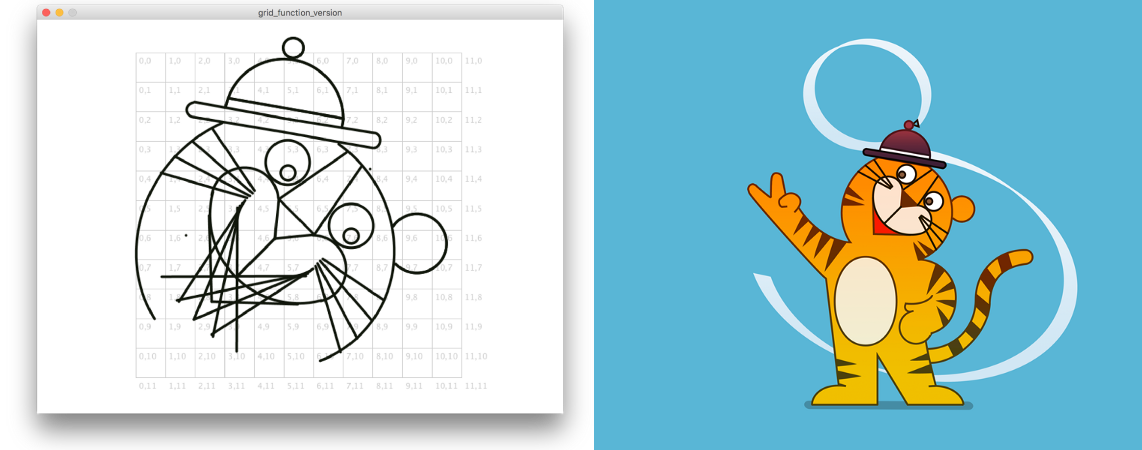
Talisman of the Olympic Games 1988
There is one more bonus from the study of geometry - you will become a better understanding of architecture.
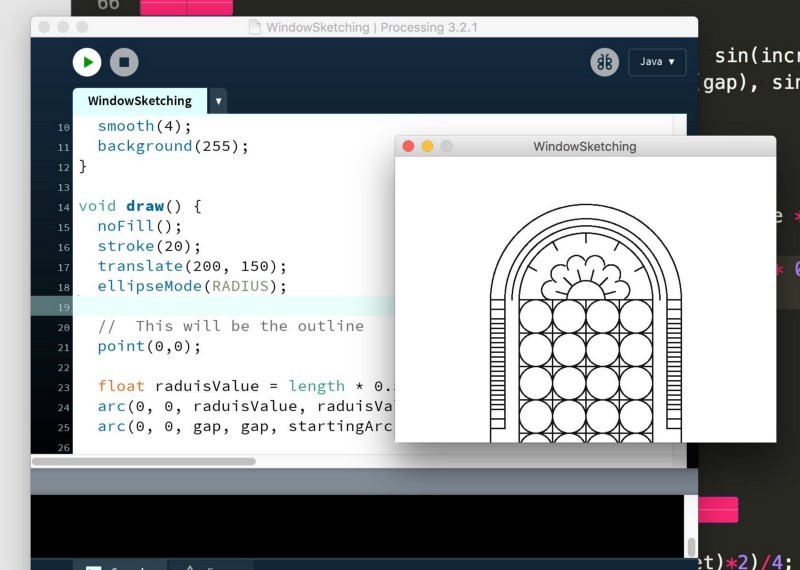
My interpretation of the architectural style of the Ginza district in Tokyo
The answer is yes !
If you intend to learn something that you have previously hated, make sure you can apply new knowledge in your core work.
In my case (I design mobile apps), I was surprised how many applications use geometry in UI design! And you can easily share your knowledge with developers, because most (or maybe all?) Programming languages in my field support mathematical expressions.
I continue to collect examples for this case, so wait for new notes :)
If you are interested in my little discoveries in mathematics, I still study something almost every weekend! Especially when I'm a little drunk, but just a little bit.
You can follow me on twitter ( @ arle13 ) to follow me as I do some funny little things.


I hated math
Math irritated me. In my youth, it seemed to me completely pointless to spend so much time on solving mathematical problems when there were so many other interesting activities around!
')
In fact, if you learn some math, you can create great concepts!
While studying at the university, I enrolled in an interactive arts course. They showed me how to create with the help of the code in Processing . Here is one example - the wonderful work of Marius Watts (since then I have been a fan of him).
Attention! Contains an overdose of awesome awesomeness.

Marius Watz <BValSys> 2011
Being an ambitious student, I tried to reproduce the style as best I could, without seeking to delve into things that were unpleasant to me. For example, I did not want to understand sin (something there) or cos (something there).

Khe-khe double loop
To be honest, I was pleased with my work. It looked interesting, and I spent much less time on it than if I did the same in Illustrator or Photoshop. And yet, I realized that without an understanding of geometry, I had no chance even to come closer to what Marius Wats was doing.
Of all the branches of mathematics, I disliked trigonometry the most. But what the difference! If you can use it to create the same cool stuff, I’m ready to sell my soul to learn math.
I started learning math again

I recommend watching the video for high school students.
Finding the study material was surprisingly easy. They are everywhere! If you are put to sleep by the sleepy voice of one presenter and the content seems too difficult to understand, there are always thousands of alternatives. Personally, I watched the Korean math teacher's YouTube channel (I'm just familiar with the content of the textbook and Korean math norms).
I can not say that I amused myself, but it helped me to understand what Marius Watz was doing: when he used cosine for position x and sine for position y.
He just put a dot on the circle!
Instead of numbers, he used trigonometric variables, so he could draw a point moving in a circle!
My first experiments in mathematics
Even when I understood the basics of trigonometry, I lacked the confidence to apply them in design. I decided to use them on something else, even if it comes out funny and not very clever. From the point of view of aesthetics, it happened somewhere in the region of its complete opposite.

http://share.framerjs.com/ejaybmwm4k95/
I AM LOL. This is so miserable. * posted to the Framer group on Facebook *
(A couple of minutes later)
I what?! Do people like it ?!
(A couple of hours later)
Me: They think I understand math. Wow!
At that time, I understood: even if you share something that you yourself think is nonsense, you can still inspire others, make them smile or smile. So I got the motivation to create new concepts and start exploring the fundamental areas of geometry.
Spinner is a great option for using trigonometry.
If you do not know where you can apply new knowledge on trigonometry - make a boot spinner (it is also a circular load indicator). I used Framer for prototyping.
Development of animations for spinner has become my favorite hobby. In any case, it looks better than a simple rotating circle, while it is not so difficult to do. You only need to think about three things:
- How many vertices will spinner have? (for example, 3 vertices)
- Where on a circle will each vertex be located? (eg every 120 degrees)
- How do you want to animate each vertex inside the loop? (e.g. in-out movement, compression-tension)

https://framer.cloud/ZePNP/

http://share.framerjs.com/e9f5sfvmrapa/
All I needed: these three steps + knowledge of the basics of trigonometry. Just like that!
After studying the circles, I moved to triangles.
For working with triangles / stars / polygons, the choice of tools is important. There are those where you can enter two points, and the system connects them with a line.
In my case, I did not use Framer. Alternatively, I could draw a rectangle and rotate it so that it turned into a line.

At first I practiced creating different shapes based on a triangle.

https://framer.cloud/rJ68Ono4g/
Mastering mathematics brings more satisfaction when you impose additional restrictions!
Here I am, polygons!
At this point, I began to say that I love math. I studied polygons and created concepts during the Christmas holidays. This is the most exciting thing I've ever had to learn.

https://framer.cloud/H1fWocJSg/
Before I got to know them better, the polygons seemed to me similar to cookie cutters. I opened Photoshop, Illustrator or Sketch and selected the necessary tool for a polygon. I could change the number of vertices from 5 to 12 - almost how to choose different molds for cookies from the box. That's all I knew about the landfills.

Octagon skeleton
Having learned more about polygons, I realized that these are beautiful structures from triangles that are just waiting to turn into something more!
Work with arcs
As I said, there are tools with which you can draw a line from point A to point B. Fortunately, this also applies to Processing! And it’s really easy to draw arcs. It revived my creative side in using mathematics.

Work in progress!

Sketches
Despite the fact that Processing is a slightly outdated language today, it has an excellent feature - the image can be exported to a pdf-file. This means that you can add more details in other programs, for example, in Illustrator and Photoshop.

Color version
Bonus - my own figures
Having understood trigonometry, triangles and polygons, you can draw anything, combining them together.
And you can sometimes fail, but it is even funny.

Talisman of the Olympic Games 1988
There is one more bonus from the study of geometry - you will become a better understanding of architecture.

My interpretation of the architectural style of the Ginza district in Tokyo
Will I be able to use it at work?
The answer is yes !
If you intend to learn something that you have previously hated, make sure you can apply new knowledge in your core work.
In my case (I design mobile apps), I was surprised how many applications use geometry in UI design! And you can easily share your knowledge with developers, because most (or maybe all?) Programming languages in my field support mathematical expressions.
I continue to collect examples for this case, so wait for new notes :)
If you are interested in my little discoveries in mathematics, I still study something almost every weekend! Especially when I'm a little drunk, but just a little bit.
You can follow me on twitter ( @ arle13 ) to follow me as I do some funny little things.

Source: https://habr.com/ru/post/400711/
All Articles